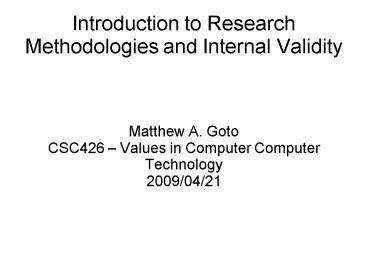Introduction to Research Methodologies and Internal Validity - PowerPoint PPT Presentation
1 / 14
Title:
Introduction to Research Methodologies and Internal Validity
Description:
Temporal Precedence: Cause comes before effect can be tricky. ... Basically, anything that could cause the result that isn't the hypothesized property/cause. ... – PowerPoint PPT presentation
Number of Views:116
Avg rating:3.0/5.0
Title: Introduction to Research Methodologies and Internal Validity
1
Introduction to Research Methodologies and
Internal Validity
- Matthew A. Goto
- CSC426 Values in Computer Computer Technology
- 2009/04/21
2
Overview
- Research Process Overview
- Overview of Research Methodologies
- Overview of Validity Types
- Potential Challenges to Internal Validity
- Solutions to Internal Validity Challenges
- Discussion/Activity
3
Research Process Overview
- Find a Question and Formalize the Problem
- Make a Hypothesis/Research Question
- Research Design aka The Plan!
- Collect Data
- Analyze the Data
- Write up Results and Publish
4
Research Methodologies Overview
- What is a Research Methodology?
- It is a way to find meaning from/in data.
- Sometimes data forces the research methodology,
e.g. historical data - Qualitative
- Attempt to describe/understand a phenomena
- Quantitative
- Attempt to predict/explain a phenomena
5
Validity Types
- Reliability the consistency that an instrument
gives the same result when the thing measured
doesn't change - Validity the extent that an instrument measures
what it is attempting to measure - Instrument Validity the extent that a research
tool provides results which are true. E.g. face,
content, criterion, construct validity - External Validity the extent that results can be
generalized to other phenomena - Internal Validity the extent that a research
design and its data provide accurate views of
relationships within the data a cause-effect
relationship
6
Showing Internal Validity
- Must have
- Temporal Precedence Cause comes before effect
can be tricky. - Covariation of Cause Effect if Cause then
Effect if not Cause then not Effect - No other explanations this is the real tricky
part!
7
Challenges to Internal Validity
- Basically, anything that could cause the result
that isn't the hypothesized property/cause. - Outside Threat maybe something outside the
research caused the result History Threat,
Maturation Threat - Design Threat maybe something in the design
caused the result Testing Threat, Instrument
Threat, Data Threat - Tangential Threat maybe something related to
the research, but (potentially) out of your
control caused the result Mortality Threat,
Regression Threat
8
Challenges to Internal Validity
- Multi-Group Studies same as single group
studies but also have to worry about
comparability of groups - Make sure that the groups are comparable prior to
the research program. Otherwise, you have a
selection threat or bias. - Best To pick out comparable groups, select an
entire group (the sample) and then randomly
assign them to a group. - Not Great, but Ok Pick out select the sample,
then non-randomly assign each individual to a
group to make the groups as equal as possible. - Social Threats Look at http//www.socialresearchm
ethods.net/kb/intsoc.php
9
Regression to The Mean
- Only a problem if non-random samples used and two
measures are imperfectly correlated - Prm 100(1 r),
- where Prm the of regression to the mean,
- r the correlation between the two measures
10
Ways to Improve Internal Validity
- Try to restrict alternate causes.
- Use random sampling of representative population
- Use a control don't use the program on 1 group
- Use a controlled laboratory study restrict
environmental contaminations - Use a double-blind experiment wrt comparing gt2
methods, don't let the methods administrators and
the participants know what is being hypothesized - Unobtrusive measures don't let the participants
know that you are measuring them - Triangulation use multiple data sources to
reduce the likelihood of alternate causes
11
Discussion/Activity
- A researcher hypothesizes that people prefer to
use Firefox over IE. What research methodology
should the researcher use and why? - A researcher wants to determine which of three
pieces of software people prefer and why they
prefer it. What methodology is best suited for
this research?
12
Discussion/Activity
- A researcher studies a group of randomly sampled
6th grade students in the US to determine whether
a teaching technique will improve understanding
of a concept. The students are divided into a
control group who get taught the concept using
the traditional teaching technique and a second
group who do get taught the concept using the new
teaching technique. Students who received the
new teaching technique did 25 better on the
post-test than those who didn't receive the new
technique. The researcher concludes that all
students will do better to be taught by the
teaching technique. - What, if any, are the validity problems for this
research?
13
Questions
- Any Questions?
- Thanks!
14
Bibliography
- Leedy, Paul D. and Ormrod, Jeanne Ellis.
Practical Research Planning and Design 8th ed.
Pearson Prentice Hall 2005. - Research Methods Knowledge Base
http//www.socialresearchmethods.net/kb. Taken
on 2009/04/21. - Picture on Regression to The Mean slide taken
from http//www.socialresearchmethods.net/kb/regr
mean.php 2009/04/21.

